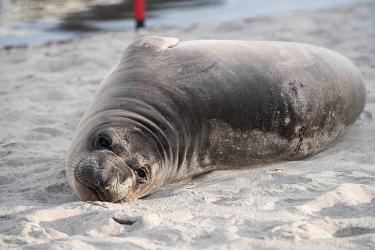What is your key responsibility?
My work is focused on estimating steelhead and rainbow trout densities and monitoring fish movement in the Carmel River and its tributaries. I capture and tag individuals with Passive Integrated Transponders tags and establish PIT-tag antenna arrays throughout the watershed. I am currently transitioning to NOAA’s California Coastal Office where I will be working as a Fish Biologist conducting Endangered Species Act consultations.
Where do you conduct your work?
My fieldwork has been located in the Carmel River and its tributaries from the headwaters upstream of the Los Padres Dam to the Carmel River Lagoon. In my new job, I will be conducting work throughout California’s coastal watersheds.
Where did you grow up?
I grew up on Guam, which is the southernmost island of the Mariana Archipelago and the westernmost territory of the United States.
What is your educational background?
I earned my B.S. in Marine Biology from Scripps Institution of Oceanography at UC San Diego.
Is there a person that influenced you to be the person that you are today?
In my professional life, I am grateful for all of my mentors, especially Andrew Thompson with the Southwest Fisheries Science Center, Mike Carey with US Geological Survey Alaska Science Center, and Haley Ohms with UC Santa Cruz and the SWFSC. I am also grateful for the support and encouragement I have received from my partner Niko Kaplanis, my parents, and my sister to pursue this career path.
What does Asian American and Pacific Islander Heritage Month mean to you?
Women and minorities face many challenges to participating in the sciences. Celebrating Asian American and Pacific Islander Heritage Month is an excellent way to acknowledge the contribution of these groups, and to make this demographic feel included and valued. Bringing the perspectives of these groups into our field will improve our ability to address challenges facing management of fishery resources. For example, in Chamorro culture, the health of our fisheries and the health of our community have always been inseparable. My people have always had a strong vested interest in the appropriate management of our fishery resources. Traditionally, men and women worked together to harvest fish by beach seine and through the use of weirs. While the labor was divided by class, all people shared the bounty at the end of the day. This sort of cooperative approach puts the community at the forefront of management decisions. Contemporary fisheries management is admittedly much more complicated, but there are many opportunities to learn from the management approaches and perspectives of subsistence fishers from communities around the globe. While harvesting fish has not been a part of my everyday life, I am grateful for the opportunity to work as a fish biologist. Doing so connects me to my past and provides me a chance to contribute to my community in a way that is meaningful. My name roughly translates as Char: “to be or to do something poorly” and Gualaf: “to hunt crab and fish by the light of the full moon.” While I may be destined to be a terrible fisher by night, I hope to serve as at least a passable fish biologist by day.
What are some of your hobbies?
I enjoy spending time outdoors backpacking, gardening, and sailing.





